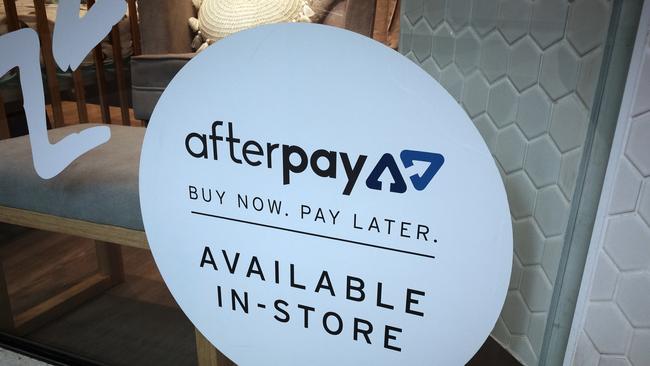Blast-off: Riding the Afterpay rocket
History is littered with companies that won big at home and blew it overseas. Is this another?

Favoured by a new generation who sidestep credit cards, this week it released its annual results with revenue increasing by 115 per cent to $251 million. To put that into perspective, the average company revenue lift on the ASX across the annual results season was 4.7 per cent.
Moreover, this acceleration in sales is taking place offshore — the “take-up” of the service is moving faster in the US and UK than it was during the group’s early years in Australia. Afterpay management and shareholders are sitting on a rocket.
Ironic, you’d have to say, that while hundreds of “fintech” companies struggle to succeed, this group with a devilishly simple twist on what we used to call “hire purchase” is shaping as one of the most successful financial companies in the world. (The Afterpay service allows a buyer to take an item immediately and pay for it in equal instalments over four fortnights. By not charging interest, the company has escaped being classified as a credit provider, which leaves it with great freedom from mandatory compliance.)
Though revenue growth might be eye-watering (underlying sales are now $5 billion), Afterpay is also a loss maker. More to the point, the losses have grown bigger, from $9m last year to $44m this year. But supporters will say Afterpay must invest in its race for global dominance in common with other loss-making disrupters such Uber, Tesla or WeWork.
But is Afterpay a giant killer or a story that might crash and burn?
The weight of history is immense here. Australia’s corporate history is littered with companies that won big time at home and blew it when they tried to take on the world. Separately, the regulators are beating at the door — most notably “money-laundering watchdog” Austrac. And you do not want to get on the wrong side of those guys, as CBA found out last year when it was hit with an Austrac fine of $700m.
There has also been very well-timed share sales by key members of the operation that unsettled the market to the point that founders Anthony Eisen, Nick Molnar and David Hancock had to publicly clarify their plans after cashing out a combined $100m in June this year.
Interpret these moves anyway you like, but whatever happens next the founders have made their fortune — as they are perfectly entitled to do.
More important perhaps than either of these concerns is that the world is waking up to just what a potentially lucrative line of business Afterpay has invented.
Here’s the stock story. It listed at $1 in 2016 and quickly acquired a related company called Touchcorp. By September 2017 it was $3, in September 2018 it was $16, this weekend it is trading near $29. For what it’s worth, the majority of brokers believe it has further to go — on average the price targets are at $31.88. It is important to point out that no broker can sufficiently analyse this stock because it is an unprecedented story. In fact, many of the best known brokers still do not cover the stock, which is highly volatile and will appear on the ASX top movers (in either direction) ever other day.
Competition stirs
It is inevitable that sooner or later the giants of modern payments such as PayPal or Apple will take on Afterpay. Meanwhile, as we wait for those moves, two global-scale rivals ex-Australia have already appeared on the horizon: The joint venture between Sweden’s “buy now, pay later” powerhouse Klarna and Commonwealth Bank announced in July, and the ASX-listed Flexipay joint venture with Mastercard
Both these ventures have the capacity to squeeze Afterpay.
But Afterpay is a long way down the road ahead of its new rivals — it has an immense grip on the retail market both online and on the high street. Better still, it appears to have managed a blend of operational capability with innovation. Consider this in terms of operations: customers who have been using the service for more than a year are transacting more than four times a year, but customers who have been using it for more than three years (mostly Australians) are transacting more than 20 times a year.
In terms of innovation, it has run a trial allowing customers a “variable” payment — the ability to pay ahead in the same way people might pay down mortgages faster than originally scheduled.
The larger story here is that Afterpay is an outstanding example of what analysts have suggested is coming with digitisation — a swarm of new players who will nip at the heels of the big banks. These operators will have low costs, global reach and nip at bank margins and slice at their most lucrative lines of revenue.
Afterpay pinches what might have been consumer finance revenue, while locally neo banks Xinja and Judo are hell bent on taking revenue that once belonged exclusively to business banking.
In the UK, neo banks Revolut and Monzo are scaring the hell out of the high street banks, taking on the lucrative foreign exchange markets and offering retail customers the opportunity to change currency at spot rates rather than the exorbitant rate that may be offered by a bank.
Afterpay might win or lose — it does not make a profit, and that is a serious concern. But it is more than just a phenomenal success. It is one of the first companies to blast a hole in the side of the banking mothership. The most remarkable thing is that it was done by a small Australian company that now has $4bn in underlying sales and aims to have $22bn by 2022.




Afterpay, the “buy now, pay later” company, is suddenly a financial juggernaut, a consumer finance multinational scaling up at a rate we have rarely seen in this market.